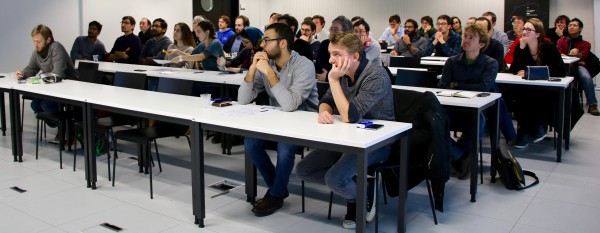MARVEL Junior Seminar — October 2021
Zoom meeting link:
https://epfl.zoom.us/j/93881551248
Password: 3417
The MARVEL Junior Seminars aim to intensify interactions between the MARVEL Junior scientists belonging to different research groups.
Each seminar consists of two presentations of 25 minutes each, allowing to present on a scientific question in depth, followed by time for discussion. The discussion is facilitated and timed by the chair.

MARVEL Junior Seminar Organizing Committee — Michele Kotiuga, Sara Fiore, Stefano Falletta, Kristians Cernevics, Max Veit and Patrick Mayor
Talk 1 — A unified theory for spectra and thermodynamics of materials via the algorithmic inversion of dynamical potentials
Tommaso Chiarotti1, Nicola Marzari1, Andrea Ferretti2
1 Laboratory of Theory and Simulation of Materials (THEOS), EPFL
2 Centro S3, CNR—Istituto Nanoscienze, Modena, Italy
Dynamical potentials appear in many advanced electronic-structure methods, including self-energies from many-body perturbation theory, dynamical mean-field theory, electronic-transport formulations, and many embedding approaches. The flexibility to predict spectral properties with frequency-dependent quantities introduces a great deal in complexity to the calculations. Here, we propose a novel treatment for the frequency dependence, introducing an algorithmic inversion method that can be applied to dynamical potentials expanded as sum over poles. This approach allows for an exact solution of Dyson-like equations at all frequencies via a mapping to a matrix diagonalization, and provides simultaneously frequency-dependent (spectral) and frequency-integrated (thermodynamic) properties of the Dyson-inverted propagators. The transformation to a sum over poles is performed introducing n-th order generalized Lorentzians as an improved basis set to represent the spectral function of a propagator. Accurate spectral and thermodynamic quantities are calculated for the homogeneous electron gas as a test case.
Talk 2 — Delicate topological insulators with and without crystalline symmetry
Tomáš Bzdušek1,2, Aleksandra Nelson2, Titus Neupert2, A. Alexandradinata3
1 Condensed Matter Theory Group, Paul Scherrer Institute (PSI)
2 Dept. of Physics, University of Zurich (UZH)
3 Physics Dept., University of California Santa Cruz, USA
Two themes have indelibly shaped the recent characterization of topological insulators. On the one hand, one can study the robustness of topological invariants of a set of bands under the addition of trivial bands. Such considerations have led to the distinction between stable and fragile topological insulators. On the other hand, one can ask whether valence bands of a given band structure can be represented by a set of exponentially-localized and symmetry-respecting Wannier orbitals. An obstruction to constructing such a Wannier representation applies to both the stable and the fragile topological insulators.
In our work [1] we refine both themes by introducing a family of topological insulators that realize another level of stability and another type of Wannier obstruction. We call these insulators “delicate” and “multicellular”. In this seminar I will explain the meaning of these notions, compare them with the already established notions, and discuss their observable consequences.
[1] A. Nelson, T. Neupert, T. Bzdušek, and A. Alexandradinata, Multicellularity of Delicate Topological Insulators, Phys. Rev. Lett. 126, 216404 (2021).
Check the list of the next MARVEL Junior Seminars here.
Low-volume newsletters, targeted to the scientific and industrial communities.
Subscribe to our newsletter